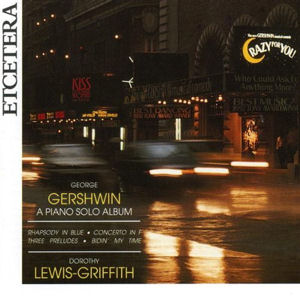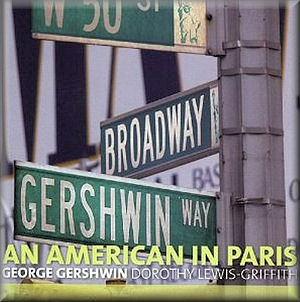 |
 |
| 

alternatively
CD: MDT
AmazonUK
AmazonUS
|
George GERSHWIN
(1898-1937)
Rhapsody in Blue (1924) [15:45]
Piano Concerto in F (1925) [33:43]
Three Preludes for Piano (1926) [7:09]
Bidin’ my Time (1930) [3:27]
 Dorothy Lewis-Griffith (piano)
Dorothy Lewis-Griffith (piano)
rec. July 1989 and March 1992, Concert Hall, University of Cambridge,
Faculty of Music, England
 ETCETERA KTC1176 [60:15]
ETCETERA KTC1176 [60:15]
|


alternatively
CD: MDT
AmazonUK
AmazonUS
Sound
Samples & Downloads |
George GERSHWIN (1898-1937)
An American in Paris (1928) [18:54]
Novelette in Fourths [9:42]
from Porgy and Bess (1935)
[29:21]
Second Rhapsody (1931) [15:44]
 Dorothy Lewis-Griffith (piano)
Dorothy Lewis-Griffith (piano)
rec. University of Cambridge, England, dates not given
 ETCETERA KTC 1419 [70:43]
ETCETERA KTC 1419 [70:43] |
| |
American pianist Dorothy Lewis-Griffith has had a long and distinguished
career. She studied at the Conservatoire de Paris and at the
École Normale de Musique. There have been numerous awards, including
a prize in the Geneva International Music Competition. This
neat little pair of CDs go well together. The recording of An
American in Paris is the more recent release and fills
in some of the gaps left by the original ‘Piano Solo Album’.
George Gershwin published very little concert music for solo
piano. Any pianist seeking to record an all-Gershwin solo album
of any kind will have to resort to transcriptions and arrangements
of one kind or another. Angela Brownridge’s ‘Complete Music
for Solo Piano’ on Hyperion Helios CDH 55006 throws in a goodly
number of Broadway numbers but actually complements these two
discs quite well rather than competing directly. It includes
arrangements of overtures and fun miniatures like Rialto
Ripples which don’t appear on these Etcetera albums. Gershwin
left his own piano solo transcription of the Rhapsody in
Blue, and this together with that of the Piano Concerto
in F by Grace Castagnetta form the basis for the first
CD. Lewis-Griffith writes that “I missed many of the textures
that I am accustomed to hearing when I played Gershwin with
orchestra … [and] had few qualms about reproducing these textures,
even though it meant amplifying Gershwin’s own transcription.”
Knowing Gershwin’s own playing style it is easy to be sympathetic
to this approach. The results are very convincing indeed, with
plenty of variety in the piano colour for the Rhapsody in
Blue. We don’t have the juicy clarinet slide in the opening
and that very first trill isn’t played perfectly. You can’t
expect everything to sound equally punchy and vibrant, but as
a solo piano version this has a great deal to commend it. Lewis-Griffith
not only swings rhythmically for the most part, but can shape
the score like an expert conductor as well as a musically sensitive
and technically proficient pianist. This is not quite the life-enhancing
experience a good orchestral performance can be, but there are
enough signals and reminders to ‘take us there’ without the
listener feeling too short-changed.
The Piano Concerto in F is a little more problematic
as a solo piece. The interaction and dialogue between soloist
and orchestra is tricky to bring off in a solo transcription
despite the piano playing a leading role in the score. It helps
if you already know the original version when unpicking who
should be doing what. There are still plenty of succulent musical
morsels to sink your aural teeth into, and there is a great
deal of magnificent playing. As something which involves working
harder – both as a listener and as a musician - I would rate
this project a couple of notches less successful than the Rhapsody
in Blue.
The first of these programmes finishes with a few fillers, of
which the Three Preludes are played with panache and
verve. The schmoozy number Bidin’ my Time comes from
the Broadway musical Girl Crazy. It makes a nice little
encore to conclude a very satisfactory Gershwin piano album.
As far as the actual recording goes the piano is set at a little
greater distance than is perhaps ideal, but the acoustic is
not intrusive, and detail and colour are communicated well.
Released more than 15 years later, the second disc treats An
American in Paris to a similarly augmented version. This
is based on previously existing arrangements but refers to the
original score to fill out missing lines and textures, and on
occasion even whole passages left out from other versions. As
a Gershwin work whose original lacks a piano part entirely,
this is considered the ‘most awkward to play’ of the works brought
together here. There are indeed some fascinating results arising
from the transcription to piano, with percussive effects reminiscent
of Stravinsky and Bartók popping out from time to time. Again,
this isn’t the kind of version which is going to replace your
favourite orchestral recordings. As with any good transcription
and performance it teaches us new things about a piece we might
even have considered over-familiar. It makes us alert to aspects
of the music which, when presented shorn of orchestral opulence,
become exposed and altered in terms of perspective.
This isn’t a perfect recording, with a deal less stereo imaging
at the outset. A sudden change at 8:25 improves the soundstage
but reveals some mildly twangy tuning problems with the upper
range of the piano. In fact the whole thing could be a good
deal more distinct and confident sounding, but the general impression
is tolerable. It is an acoustic picture to which you can become
accustomed without too much strain.
The Novelettes are of interest in this recording. Gershwin
biographer, the late Edward Jablonski, gave Dorothy Lewis-Griffith
copies of unpublished manuscripts to three Gershwin preludes,
but the manuscript to the Novelette in Fourths was
incomplete. Gershwin had however extended the piece in one of
his piano roll recordings. Lewis-Griffith transcribed the sixteen
measure extension from that recording and has included in the
version on this CD. Each of these pieces is filled with easy
charm, being related in terms of mood and even thematic material.
The Sleepless Night and Melody 17 are variants
of each other and are played here without a break.
The numbers of Porgy and Bess need little introduction,
and Lewis-Griffith plays them atmospherically and with suitable
lyrical finesse. There is a nice sense of wit to songs like
There’s a Boat Dat’s Leavin’. I like the way the soloist
doesn’t ham up the more sentimental tunes too much. This is
a kind of souvenir recording, “mere reminders of that landmark
1935 creation” as the booklet notes put it, but still a fine
collection to have.
This second disc concludes with the Rhapsody or Second
Rhapsody as it has become known. The score is another transcription
made by Dorothy Lewis-Griffith. The piece is once again brought
to life with suitably full and juicy pianistic sounds. Less
familiar than the Rhapsody in Blue, this is a piece
with cinematic associations and a good deal of visual hustle
and bustle. This is communicated here with character and conviction.
Dorothy Lewis-Griffith has made these pieces her own in these
recordings. Both of these CDs are easy to recommend and nice
to have around. I’m not going to compare these versions with
other orchestral recordings. They will always be something of
a supplement to the best of what is already a pretty full current
Gershwin catalogue. Lewis-Griffith certainly has the chops to
manage some fiendishly tricky passages in these transcriptions.
While she might not be the jazziest or most ebullient performer
on the planet I have certainly not come away from these with
any sense of, ‘nice, but if only…’ Even with mildly dodgy production
values in the American in Paris programme, fans of
the piano and the ways it can be stretched to incorporate an
entire orchestra can have great fun with these versions. If
you are lucky enough to be given one you will certainly want
the other.
Dominy Clements
|
|

